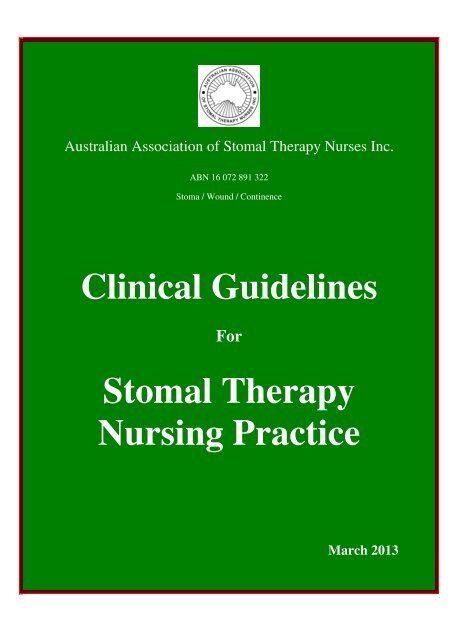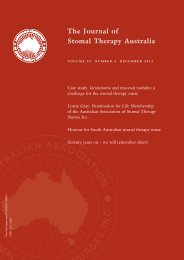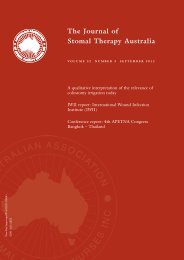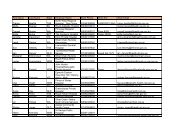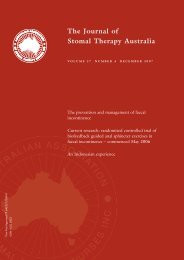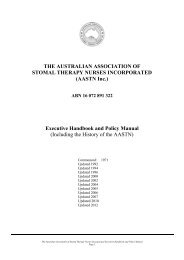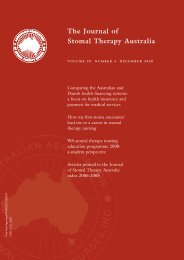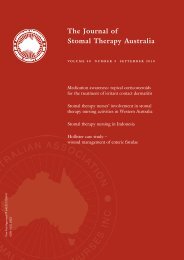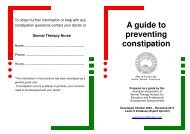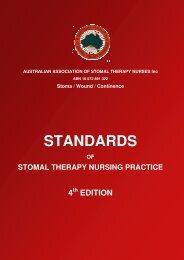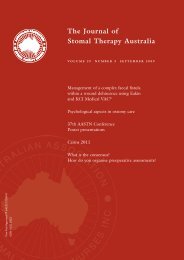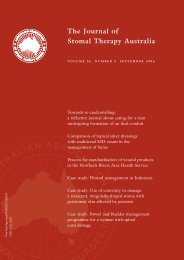Clinical Guidelines Stomal Therapy Nursing Practice - Australian ...
Clinical Guidelines Stomal Therapy Nursing Practice - Australian ...
Clinical Guidelines Stomal Therapy Nursing Practice - Australian ...
Create successful ePaper yourself
Turn your PDF publications into a flip-book with our unique Google optimized e-Paper software.
<strong>Australian</strong> Association of <strong>Stomal</strong> <strong>Therapy</strong> Nurses Inc.ABN 16 072 891 322Stoma / Wound / Continence<strong>Clinical</strong> <strong>Guidelines</strong>For<strong>Stomal</strong> <strong>Therapy</strong><strong>Nursing</strong> <strong>Practice</strong>March 2013
DevelopmentThese guidelines have been developed by the members of the Education and ProfessionalDevelopment Subcommittee over a period of two years, in consultation with other expert <strong>Stomal</strong><strong>Therapy</strong> Nurses around Australia.AcknowledgementThe guidelines are based on an initial proforma developed by our credentialed <strong>Stomal</strong> <strong>Therapy</strong>Nurse Caroline Harrison, <strong>Clinical</strong> Nurse Consultant in <strong>Stomal</strong> <strong>Therapy</strong> <strong>Nursing</strong> at Austin Health,Melbourne. Our thanks are offered to her for permission to continue to use this after she could nolonger participate directly in the final compilation.DisclaimerThese guidelines have been developed to assist the <strong>Stomal</strong> <strong>Therapy</strong> Nurse in practice and are notbinding on the Nurse or the Organisation that employs them. They constitute neither liability nordischarge from liability. While every effort has been made to ensure accuracy of information the<strong>Australian</strong> Association of <strong>Stomal</strong> <strong>Therapy</strong> Nurses Inc. (AASTN) does not give any guarantee ofthe information contained within the guidelines or accept any liability with respect to injury,expense, damage or loss arising from omission or errors contained within the content of theseguidelines.<strong>Clinical</strong> <strong>Guidelines</strong>: <strong>Stomal</strong> <strong>Therapy</strong> <strong>Nursing</strong> <strong>Practice</strong> 2
TABLE OF CONTENTSPageBackground 3CLINICAL GUIDELINESDigital examination of an ileostomy / colostomy 5Bowel Preparation* Oral bowel preparation for a patient with a colostomy 6* Distal loop or mucous fistula washout 7* Administration of a suppository into a colostomy 8* Administration of an enema into a colostomy 9Routine Management* Peristomal skin 10* Leaking stoma appliance 12Removal of a rod from a loop stoma 14Complications* Oedematous stoma management 15* Parastomal hernia management 16* Treatment of granulomas with silver nitrate 18* Prolapsed stoma management 20Ileal Conduit / Urostomy* Urine specimen from conduit 22* Removal of ureteric stents from a urostomy 24Nephrostomy tube care 26Percutaneous Endoscopic Gastrostomy (PEG)* PEG tube peristomal skin care 28* Removal of hypergranulation tissue around a PEG tube 30Reference List 32Bibliography 33<strong>Clinical</strong> <strong>Guidelines</strong>: <strong>Stomal</strong> <strong>Therapy</strong> <strong>Nursing</strong> <strong>Practice</strong> 4
DIGITAL EXAMINATION OF AN ILEOSTOMY / COLOSTOMYPERFORMED BYCLINICAL ALERTRELATED GUIDELINE• <strong>Stomal</strong> <strong>Therapy</strong> Nurse• Medical staff• Registered Nurse• Do not perform on neonates• Caution with children and adolescents• Perforation• BleedingAdministration of a Suppository into a ColostomyRATIONALE Performed to examine the lumen e.g. patency and direction1, 2, 3EXPECTEDOUTCOMESCONSIDERATIONSIN CONSULTATIONWITH• To ascertain patency of bowel proximal to stomal egress point• To identify the direction of the lumen• Ensure verbal permission has been obtained• A loop stoma will have two lumens: insert gloved, lubricatedindex finger into the proximal (functioning) or distal lumen asrequired• Carefully feel for the direction of the lumen• If no blockage is felt and the lumen is stenosed (tight), repeatprocedure using ring or middle finger to establish diameter of thelumen 1, 2<strong>Australian</strong> Association of <strong>Stomal</strong> <strong>Therapy</strong> Nurses Inc. Education andProfessional Development SubcommitteeREFERENCES 1. Black P. Holistic stoma care. London: Bailliere Tindal. 2000.2. Breckman B. Stoma care and rehabilitation. London: Elsevier. 2005.3. Blackley P. Practical stoma wound and continence management. 2 nded. Victoria: Research Publications. 2004.<strong>Clinical</strong> <strong>Guidelines</strong>: <strong>Stomal</strong> <strong>Therapy</strong> <strong>Nursing</strong> <strong>Practice</strong> 5
ORAL BOWEL PREPARATION FOR A PATIENT WITH A COLOSTOMYPERFORMED BYCLINICAL ALERTRELATED GUIDELINERATIONALEEXPECTED OUTCOMECONSIDERATIONSIN CONSULTATIONWITHREFERENCES• <strong>Stomal</strong> <strong>Therapy</strong> Nurse• <strong>Clinical</strong> Nurse• Depending on the Medical Officer’s preference – no bowelpreparation may be required pre-operatively• Contraindicated in patients with gastrointestinal obstruction,inflammation of the bowel, undiagnosed abdominal pain,nausea, vomiting, colic and abdominal cramps• Need to ascertain bowel patency – potential for perforation ifobstructed 1• Check hydration status – dehydration or electrolyte imbalancemay result• Up to 50 % of patients will experience abdominal fullness,bloating and nausea• Observe for adverse reactions e.g. abdominal cramps andvomitingDigital Examination of an Ileostomy / ColostomyTo cleanse the bowel free from faecal matter:o reduces bacterial load and the risk of infection with surgeryo provides optimal visibility of the bowel wall during imagingand diagnostic tests 2An empty colon with reduced bacterial load• Ensure a written order has been obtained prior toadministration• Ensure flatus is being passed prior to administration of any oralaperients• Change appliance to an irrigation sleeve or drainable pouch• Monitor hydration status in frail patients<strong>Australian</strong> Association of <strong>Stomal</strong> <strong>Therapy</strong> Nurses Inc. Educationand Professional Development Subcommittee1. Blackley P. Practical stoma wound and continencemanagement. 2 nd ed. Victoria: Research Publications. 2004.2. Burch J. Stoma care. Hong Kong: Wiley-Blackwell. 2008.<strong>Clinical</strong> <strong>Guidelines</strong>: <strong>Stomal</strong> <strong>Therapy</strong> <strong>Nursing</strong> <strong>Practice</strong> 6
DISTAL LOOP OR MUCOUS FISTULA WASHOUTPERFORMED BYCLINICAL ALERTRELATED GUIDELINERATIONALEEXPECTED OUTCOMECONSIDERATIONSIN CONSULTATION WITHREFERENCES• <strong>Stomal</strong> <strong>Therapy</strong> Nurse• Other nurses trained in the procedure• Medical staffPotential complications include:o trauma to - stomao vasovagal episodeo discomfort /cramps- bowel wall (including perforation)- lesions if present in distal bowelDigital Examination of an Ileostomy / ColostomyTo flush the distal colon and rectum with water (or solution asordered) to clear faeces / mucus as diagnostic or pre-operativepreparationThe distal bowel is clean and empty• Ensure verbal permission has been obtained• Examine the bowel digitally (see digital examination guidelinefor paediatric patients) to rule out presence of local tumour 1and to identify the direction of the lumen• Apply lubricating jelly to tip of irrigation cone or catheterand insert into the distal loop of the stoma or mucous fistula• Slowly administer tepid fluid from the irrigation set orsyringe, monitoring the patient for any signs of discomfort• Monitor for return of fluid through the anus• Volume instilled dependent upon individual requirements 2• Document the procedure and result in the patient’s records<strong>Australian</strong> Association of <strong>Stomal</strong> <strong>Therapy</strong> Nurses Inc. Educationand Professional Development Subcommittee1. Breckman B. Stoma care & rehabilitation. London: Elsevier.2005.2. Cesaretti R., de Gouveia Sabtos V., Schtan S. & Vianna L.Colostomy irrigation: review of technical aspects. ActaPaulista Enfermagem. 2008. 212 (2): 338 – 344.<strong>Clinical</strong> <strong>Guidelines</strong>: <strong>Stomal</strong> <strong>Therapy</strong> <strong>Nursing</strong> <strong>Practice</strong> 7
ADMINISTRATION OF A SUPPOSITORY INTO A COLOSTOMYPERFORMED BYCLINICAL ALERTRELATED GUIDELINERATIONALEEXPECTED OUTCOMESCONSIDERATIONSIN CONSULTATION WITH• <strong>Stomal</strong> <strong>Therapy</strong> Nurse• Medical staff• Registered NursePotential complication – perforationDigital Examination of an Ileostomy / Colostomy• Relieve symptoms of constipation• Administer medication directly to the bowel wall• Utilise alternative medication route when oral route is unavailableor contraindicated eg fastingRelief of symptoms of constipationEffective medication use• Ensure verbal permission has been obtained• Examine the bowel digitally (see digital examination guideline forpaediatric patients) prior to insertion of suppository to rule out thepresence of local tumour 1 or blockage• Slowly insert lubricated digit into the colostomy to identify thedirection of the lumen• Apply lubricating jelly to each suppository and slowly insert,monitoring for any discomfort• The suppositories will need to be held in place while dissolving• A stoma plug (e.g. Conseal TM plug) or anal plug may be used to holdthe suppositories in place (not paediatric patients)• Remove any plug when sufficient time has elapsed for the suppositoriesto dissolve – follow package instruction• Ensure a drainable bag or irrigation sleeve is applied• Follow up outcome / result and document• For constipation:o review medication list for drugs with this side effecto educate patient on importance of high fibre diet, exercise andfluid intake<strong>Australian</strong> Association of <strong>Stomal</strong> <strong>Therapy</strong> Nurses Inc. Education andProfessional Development SubcommitteeREFERENCE 1. Breckman B. Stoma care & rehabilitation. London: Elsevier. 2005.<strong>Clinical</strong> <strong>Guidelines</strong>: <strong>Stomal</strong> <strong>Therapy</strong> <strong>Nursing</strong> <strong>Practice</strong> 8
ADMINISTRATION OF AN ENEMA VIA A COLOSTOMYPERFORMED BY • <strong>Stomal</strong> <strong>Therapy</strong> Nurse• Registered nurse competent with the procedure• Medical staffCLINICAL ALERT • Potential complications include:o Perforationo Water & electrolyte disturbancesRELATED GUIDELINESRATIONALEEXPECTED OUTCOMECONSIDERATIONSIN CONSULTATIONWITHDigital Examination of an Ileostomy / ColostomyDistal Loop or Mucous Fistula WashoutPerformed to evacuate the bowel, usually to relieve symptoms ofconstipation / faecal impaction or to cleanse the bowel prior to a diagnosticor surgical procedureAn empty bowel, either proximal or distal, dependant upon reason forprocedure• Ensure verbal permission is obtained• Apply a long bag over the stoma with opening at top for insertion of theenema• Identify the proximal and / or distal lumens• Slowly insert a digit (see digital examination guideline for paediatricpatients) into the appropriate lumen to identify the direction beforeinstilling the solution• Apply lubricating jelly to tip of enema container and insert oralternatively:o attach the tip of the enema container to an irrigation coneo insert a Foley catheter well into the stoma and inflate the balloon to5 ml so it will aid retention of the enema 1• Slowly administer enema contents, monitoring the patient for any signsof discomfort• The solution will need to be retained within the stoma for therecommended length of time. The irrigation cone or Foley catheter willassist with this. Deflate the balloon immediately after recommendedlength of time• Document the procedure and result in the patient’s records<strong>Australian</strong> Association of <strong>Stomal</strong> <strong>Therapy</strong> Nurses Inc. Education andProfessional Development SubcommitteeREFERENCE 1. Breckman B. Stoma care & rehabilitation. London: Elsevier. 2005.<strong>Clinical</strong> <strong>Guidelines</strong>: <strong>Stomal</strong> <strong>Therapy</strong> <strong>Nursing</strong> <strong>Practice</strong> 9
PERISTOMAL SKIN – ROUTINE MANAGEMENTPERFORMED BYCLINICAL ALERTRELATED GUIDELINERATIONALEEXPECTEDOUTCOMESCONSIDERATIONS• <strong>Stomal</strong> <strong>Therapy</strong> Nurse (STN)• <strong>Nursing</strong> staff• Medical staff• Carers and persons with a stoma• Skin interruption / damage may result from:o mechanical trauma (shearing, pressure, friction) 1o irritant contact dermatitis (due to faeces, urine, chemicals) 1o allergyo problems related to existing disease (eg Psoriasis, Crohn’sdisease) 1o infection by pathogenic microorganisms 1• Potential complications include:o pain / soreness / itcho poor appliance adherenceo faecal / urinary leakageo psychological distress and lack of confidenceManagement of Leaking Stoma ApplianceTo maintain integrity of peristomal skin• Peristomal skin integrity is maintained• <strong>Stomal</strong> appliance adhesion and functionality is enhanced• Assess peristomal skin to determine skin integrity• In presence of skin integrity disturbance, identify the cause andinitiate appropriate management• Selection of an appliance with consideration of:o size and shape of stomao peristomal skin and abdominal wall contourso frequency and consistency of outputo patient and carer ability to manage stoma and skino avoiding the use of unnecessary products• Water and a lint-free cloth are generally all that is required forcleaning the peristomal skin 2<strong>Clinical</strong> <strong>Guidelines</strong>: <strong>Stomal</strong> <strong>Therapy</strong> <strong>Nursing</strong> <strong>Practice</strong> 10
• As indicated, periodic or ongoing review of the peristomal skin• Use of a specific skin assessment tool is beneficial 3• Patient / carer education in maintaining healthy peristomal skin, thesigns and symptoms of skin complications and when to consult ahealth care professional 1IN CONSULTATIONWITHREFERENCES• Dermatologist, Colorectal Surgeon, Urologist, Gastroenterologist,STN• <strong>Australian</strong> Association of <strong>Stomal</strong> <strong>Therapy</strong> Nurses Inc. Educationand Professional Development Subcommittee1. Claessens I., Cobos Serrano J., English E., Martins L. & TavernelliK. Peristomal skin disorders and the ostomy skin tool. WorldCouncil of Enterostomal Therapists Journal. 2008. 28 (2): 26 – 27.2. Lyon C. & Smith A. (Eds). Abdominal stomas and their skindisorders: An atlas of diagnosis and management. 2 nd ed. UK:Informa. 2010.3. Martins L., Tavernelli K. & Cobos Serrano J. Introducing aperistomal skin assessment tool: The Ostomy Skin Tool. WorldCouncil of Enterostomal Therapists Journal. 2008. 28 (2)Supplement: 10 – 13.<strong>Clinical</strong> <strong>Guidelines</strong>: <strong>Stomal</strong> <strong>Therapy</strong> <strong>Nursing</strong> <strong>Practice</strong> 11
LEAKING STOMA APPLIANCE – ROUTINE MANAGEMENTPERFORMED BYCLINICAL ALERTRELATED GUIDELINERATIONALEEXPECTED OUTCOMECONSIDERATIONS• Registered Nurse• Patient• Carer educated in stoma management• Identify why and how the appliance is leaking• Skin integrity can be compromised very quickly by effluent• Stoma or abdominal wall changes may affect adhesion• Life style activities can be severely altered due to lack ofconfidence and embarrassmentRoutine Management of Peristomal SkinStoma appliances should not leak when selected appropriatelyand applied correctlyA correctly fitting stoma appliance which does not leak• Reassure patient that the problem can be solved• Obtain detailed description of problem• Identify the leakage site and effects by observing the:o patient’s techniques for emptying and removing applianceo pouch and wafer for evidence of cause of leakageo stoma and muco-cutaneous junctiono peri-stomal skin condition 1o abdominal wall for creases, hernia, granuloma, etco changes in abdominal wall contours in different positions(sitting, lying, standing)• Identify any inflammation, infection, allergy etc and refer to<strong>Stomal</strong> <strong>Therapy</strong> Nurse as appropriate• Ensure skin is clean, dry and protected prior to waferapplication• Measure stoma and ensure wafer fits close to the stoma• Select appropriate appliance to remedy identified issues• Educate patient regarding appliance and identified solution• Provide written material for on-going support• Document findings• Provide feedback to other care workers as appropriate 2<strong>Clinical</strong> <strong>Guidelines</strong>: <strong>Stomal</strong> <strong>Therapy</strong> <strong>Nursing</strong> <strong>Practice</strong> 12
• Consult <strong>Stomal</strong> <strong>Therapy</strong> Nurse if problems persistIN CONSULTATION WITHREFERENCES<strong>Australian</strong> Association of <strong>Stomal</strong> <strong>Therapy</strong> Nurses Inc. Educationand Professional Development Subcommittee1. Martins L., Tavernelli K. & Cobos Serrano J. Introducing aperistomal skin assessment tool: The Ostomy Skin Tool.World Council of Enterostomal Therapists Journal. 2008. 28(2) Supplement: 10 – 13.2. Perrin A. Using the Ostomy Skin Tool to assistcommunication between ostomy care nurses. World Councilof Enterostomal Therapists Journal. 2008. 28 (2) Supplement:14 – 15.<strong>Clinical</strong> <strong>Guidelines</strong>: <strong>Stomal</strong> <strong>Therapy</strong> <strong>Nursing</strong> <strong>Practice</strong> 13
REMOVAL OF A ROD FROM A LOOP STOMAPERFORMED BYCLINICAL ALERT• <strong>Stomal</strong> <strong>Therapy</strong> Nurse• Medical staff• Early removal of the rod may result in the stoma retracting intothe abdominal cavity• Trauma to the stoma if there is too much tension over the rod• Trauma to the peristomal skin caused by pressure from the rod(if a rigid flat rod is used)• Rod is removed on day five to seven unless contraindicated, oras per Surgeon’s preference 1RELATED GUIDELINERATIONALEEXPECTED OUTCOMECONSIDERATIONSThe rod is removed once the spur or ridge between the two openingshas formed 1To safely remove the rod without stomal retraction• <strong>Clinical</strong> assessment of stoma indicating readiness for rodremoval• Check that the rod is loose and mobile (free to move beneath theloop of bowel) and there are no sutures• Review peristomal skin and mucocutaneous junction afterremoval• Document procedure and findings• There are a number of rods available which work the same waybut are removed slightly differentlyIN CONSULTATIONWITHREFERENCE<strong>Australian</strong> Association of <strong>Stomal</strong> <strong>Therapy</strong> Nurses Inc. Education andProfessional Development Subcommittee1. Breckman B. Stoma care and rehabilitation. London: Elsevier.2005.<strong>Clinical</strong> <strong>Guidelines</strong>: <strong>Stomal</strong> <strong>Therapy</strong> <strong>Nursing</strong> <strong>Practice</strong> 14
OEDEMATOUS STOMA MANAGEMENTPERFORMED BYCLINICAL ALERTRELATED GUIDELINERATIONALEEXPECTED OUTCOMECONSIDERATIONSIN CONSULTATION WITHREFERENCES• <strong>Stomal</strong> <strong>Therapy</strong> Nurse• <strong>Clinical</strong> Nurse• Medical Officer• Some oedema is expected in a newly formed stoma but maybecome excessive if a haematoma forms 1• If oedema develops in well established stomas, the cause mustbe identified – may be due to prolapse, chemotherapy,radiotherapy, low blood albumin,• Appliance may be too tight and cause oedema / trauma• Need to measure stoma as baseline for wafer sizing and toprevent it becoming too tight• Note colour of mucosa – venous and lymphatic drainage maybecome congested / compromisedRoutine Management – Peristomal SkinReduction of oedema enables correct appliance fittingGradual reduction in oedema and stoma size over 24 – 48 hours• Carefully remove appliance and review aperture size• Cut wafer larger than stoma and use seals to protect skinintegrity and provide flexibility. Radial slits may also addflexibility 2• Reapply post-operative appliance with adequate clearance ofstoma without compromising skin integrity• Reassure patient that post-operative oedema is to be expected• Advise Medical Officer and document findings• Review daily (or more frequently if needed)• A small sprinkle of sugar on mucosa of an established stomamay reduce swelling and assist with reducing any prolapse<strong>Australian</strong> Association of <strong>Stomal</strong> <strong>Therapy</strong> Nurses Inc. Educationand Professional Development Subcommittee1. Blackley P. Practical stoma wound and continencemanagement. 2 nd ed. Victoria: Research Publications. 2004.2. Stelton S. and Homsted J. An ostomy-related problem solvingguide for the non-ostomy therapist professional. WorldCouncil of Enterostomal Therapists Journal. 2010. 30 (3): 10.<strong>Clinical</strong> <strong>Guidelines</strong>: <strong>Stomal</strong> <strong>Therapy</strong> <strong>Nursing</strong> <strong>Practice</strong> 15
PARASTOMAL HERNIA MANAGEMENTPERFORMED BY • <strong>Stomal</strong> <strong>Therapy</strong> Nurse (STN)• <strong>Nursing</strong> staff• Medical staff• Carers and persons with a stomaCLINICAL ALERTRELATED GUIDELINERATIONALEEXPECTED OUTCOMEPotential complications include:oocontour deformity adjacent to stomaalteration to shape and / or size of stomao bowel incarceration 1obowel obstruction (partial or complete)o bowel perforation 1oocompromise to the abdominal wall skin and tissue due tostretching associated with the hernia sac 1complication of colostomy irrigation as mode of stomamanagemento urinary conduit interruption e.g. deteriorating upper tract 2 ,infection 2 , metabolic disturbance, distortion of urinaryconduitooodiscomfort / crampsnausea and vomitingpsychological distresso exacerbation of respiratory problems 1o back pain 1Routine Management – Leaking Stoma ApplianceManagement of the parastomal hernia to:o relieve pain and discomforto minimise body image disturbanceo minimise disruption to appliance and stoma managementassociated with the parastomal herniao minimise complications associated with herniation 3The effects of the hernia are minimisedCONSIDERATIONS • Patient education about:o exercises to increase core abdominal strength 1 : if possible,preoperatively as well as postoperatively<strong>Clinical</strong> <strong>Guidelines</strong>: <strong>Stomal</strong> <strong>Therapy</strong> <strong>Nursing</strong> <strong>Practice</strong> 16
o avoidance of activities that increase intra-abdominalpressure (lifting weights) and early intervention for coughs 1o signs and symptoms of bowel obstruction and incarceration 1• Fitting of hernia support garments to relieve symptoms• Review and advise on appropriate stoma appliance• Regular follow-up by the STN to monitor progress of hernia 1• Document the outcome / education in the patient’s recordsIN CONSULTATIONWITHREFERENCES• Colorectal Surgeon, Urologist, STN• <strong>Australian</strong> Association of <strong>Stomal</strong> <strong>Therapy</strong> Nurses Inc.Education and Professional Development Subcommittee1. Thompson J.M. Parastomal hernias revisited, including a costeffectiveness analysis: Is an ounce of prevention worth a poundof cure? Journal of <strong>Stomal</strong> <strong>Therapy</strong> Australia. 2008. 29(2): 6 –15.2. Burch J. Stoma care. UK: Wiley-Blackwell. 2008.3. Hardt J., Herrl F. & Kienle P. Lateral para-rectal placementversus transrectal stoma siting for the prevention of parastomalherniation. (Protocol) The Cochrane Collaboration. TheCochrane Library: Issue 12. John Wiley. 2011.<strong>Clinical</strong> <strong>Guidelines</strong>: <strong>Stomal</strong> <strong>Therapy</strong> <strong>Nursing</strong> <strong>Practice</strong> 17
TREATMENT OF GRANULOMAS WITH SILVER NITRATEPERFORMED BY• <strong>Stomal</strong> <strong>Therapy</strong> Nurse (STN)• Medical staffCLINICAL ALERT • Silver nitrate can cause burns if used incorrectly 1RELATED GUIDELINE• Long-term use may cause inflammatory responses or metabolicdisturbances 1• Check for extraneous material e.g. sutures 2• Medical consultation to identify other causes or factors forconsideration is advisable before cauterisation 3DEFINITIONRATIONALEEXPECTED OUTCOMEEQUIPMENTPROCEDUREExcess granulation tissue can form around the stoma, sometimes as aresult of an ill-fitting appliance or in response to a foreign body e.g.2, 3.sutures It is friable and bleeds readily. Silver nitrate is used tocauterise a problematic bleeding pointTreating bleeding granulomas cauterises the bleeding point andmakes stoma management easier for the patientBleeding is reduced / ceased, allowing easier management of stoma• Clean stoma appliance• Warm water• Dry wipes• Rubbish bag• Gloves• Silver nitratematch-sticks• Explain the procedure to the patient and prepare the equipment• Apply gloves• Remove soiled stoma appliance: clean and dry stoma site• Identify bleeding points• Apply silver nitrate to the granulomas to seal the bleeding point:the mucosa will turn grey in colour 1 . Reassure the patient• Care must be taken to avoid contact with the skin – silver nitrate1, 2, 3can cause painful burns• Ensure the peristomal skin is clean and dry: re-apply appliance<strong>Clinical</strong> <strong>Guidelines</strong>: <strong>Stomal</strong> <strong>Therapy</strong> <strong>Nursing</strong> <strong>Practice</strong> 18
• Dispose of silver nitrate match-stick in accordance with Health &Safety procedures 4Post Procedure• Ensure patient understands that the discolouration is normal, andthat normal colour will return over the next 24 – 48 hrs 1• Arrange a follow-up appointment, as further treatment may benecessary• Large granulomas may not resolve with silver nitrate and mayneed to be surgically excised 2• Document procedure in patient’s medical historyCONSIDERATIONSREFERENCESThe STN:o Understands need for treatment and reasons for granulomaformationo Treats granulomas with an understanding of the expectedoutcomeo Ensures appropriate follow-up of the patient for furthertreatment or review1. Minkes R., Chen L. & Mazziotti M. Disorders of the umbilicus.Accessed 30/1/2012.http://emedicine.medscape.com/article/935618-overview 2010.2. Breckman B. Stoma care & rehabilitation. London: Elsevier.2005.3. Connolly M., Armstrong J. & Buckley D. Tender papules arounda stoma. <strong>Clinical</strong> and experimental dermatology. 2005. 31(1):165 – 166.4. G.F. Health Products Inc. 2011.<strong>Clinical</strong> <strong>Guidelines</strong>: <strong>Stomal</strong> <strong>Therapy</strong> <strong>Nursing</strong> <strong>Practice</strong> 19
PROLAPSED STOMA MANAGEMENTPERFORMED BYCLINICAL ALERT• <strong>Stomal</strong> <strong>Therapy</strong> Nurse (STN)• Medical Officer• Registered Nurse• Protrusion of a stoma may arise:o Suddenly or gradually and increase in length and diametero With increased intra-abdominal pressure from coughing,urinary retention, pregnancy, constipation or malignancy• Protrusion of a stoma may cause:o Constriction of venous return or arterial supplyo Damage to mucosa from a too tight wafero Obstruction to effluento Difficulty applying a wafer or poucho Patient distressRELATED GUIDELINERATIONALEEXPECTED OUTCOMESCONSIDERATIONSIntussusception of (usually) a distal loop bowel segment may besliding (retracts when patient is supine) or fixed 1, 2• Retraction or reduction of stoma• Effective stoma management with a suitable appliance• Prevention of further complications• Reassurance of the patient• Observe stoma for:o Perfusion statuso Constriction / traumao Faecal or urinary output• Attempt reduction of stoma in supine position after cold packor sugar application to reduce oedema<strong>Clinical</strong> <strong>Guidelines</strong>: <strong>Stomal</strong> <strong>Therapy</strong> <strong>Nursing</strong> <strong>Practice</strong> 20
• Select appliance size and style with size of prolapse in mind• Refer for surgical review and STN follow-up• Consider the use of supportive undergarments• Document findings and outcome• Educate patient about expected ostomy colour andmanagement 1, 2IN CONSULTATIONWITHREFERENCES<strong>Australian</strong> Association of <strong>Stomal</strong> <strong>Therapy</strong> Nurses Inc. Educationand Professional Development Subcommittee1. Blackley P. Practical stoma wound and continence management.2 nd ed. Victoria: Research Publications. 2004.2. Breckman B. Stoma care and rehabilitation. London: Elsevier.2005..<strong>Clinical</strong> <strong>Guidelines</strong>: <strong>Stomal</strong> <strong>Therapy</strong> <strong>Nursing</strong> <strong>Practice</strong> 21
URINE SPECIMEN COLLECTION FROM A UROSTOMYPERFORMED BY • <strong>Stomal</strong> <strong>Therapy</strong> Nurse• Registered Nurse trained in procedure• Medical StaffCLINICAL ALERT • Urine from a conduit may be cloudy due to presence of mucus –do not confuse for infectionRELATED GUIDELINE• Specimen must not be collected from a urostomy appliance as itwill be contaminated• Understanding of anatomy of an ileal / colonic conduit 1RATIONALEEXPECTED OUTCOMETo collect a specimen of urine from a patient with an ileal conduitfor microscopy and culture 2Urine from a patient with an ileal / colonic conduit for microscopyand culture must reflect actual urine content, not contamination 2To safely obtain an uncontaminated specimen of urineCONSIDERATIONS • Specimen may be obtained by insertion of a Nelaton catheterinto the stoma or by holding a sterile specimen container at theunderneath edge of a clean stoma• Stoma must be washed with sterile water or saline prior tocollection• Encourage oral fluid intake prior to procedureEquipment:• Sterile gloves• Sterile water or saline for washing stoma• Nelaton catheter no larger than 14 Fr• Sterile specimen containerProcedure:• Prepare equipment and wash hands• Remove stoma appliance and cover stoma with a swab• Clean stoma with sterile solution from centre outwards• Insert catheter tip gently into stoma and beyond abdominal wallfascia to a depth of 2.5 – 5 cm only• If urine does not flow, ask client to change position / cough<strong>Clinical</strong> <strong>Guidelines</strong>: <strong>Stomal</strong> <strong>Therapy</strong> <strong>Nursing</strong> <strong>Practice</strong> 22
• Allow approx 10 – 15 ml of urine to drain into sterile specimencontainer• Remove catheter and replace stoma appliance• Alternatively, hold the sterile specimen container below theunderneath edge of the cleaned stoma to collect urine• Label and send specimenIN CONSULTATIONWITHREFERENCES<strong>Australian</strong> Association of <strong>Stomal</strong> <strong>Therapy</strong> Nurses Inc. Educationand Professional Development Subcommittee1. Glasgow University Hospitals NHS Division <strong>Clinical</strong> ProcedureManual. Section G.2. Dougherty L. & Lister S. (Eds) The Royal Marsden HospitalManual of <strong>Clinical</strong> <strong>Nursing</strong> Procedures. Wiley-Blackwell. 2011.<strong>Clinical</strong> <strong>Guidelines</strong>: <strong>Stomal</strong> <strong>Therapy</strong> <strong>Nursing</strong> <strong>Practice</strong> 23
REMOVAL OF URETERIC STENTS FROM A UROSTOMYPERFORMED BYCLINICAL ALERT• <strong>Stomal</strong> <strong>Therapy</strong> Nurse• Medical Officer• Awareness of surgery and purpose of ureteric stents isnecessary 1• Urology team must document removal date in patient’snotes• Stents may be left insitu for 10 days or as per Urologist’spreference – may be left longer if pre-operativeradiotherapy has been given• If stents do not dislodge with gentle traction do not continue• Stents are sometimes sutured within the stomal orifice 2RELATED GUIDELINERATIONALEEXPECTED OUTCOMESCONSIDERATIONS• Ureteric stents are fine bore tubes which protrude from thelumen of the stoma and into the urostomy appliance 3• Stents maintain the patency of the uretero-ileal anastomosis(ileal conduit) or uretero-colonic anastomosis (colonicconduit) and prevent stenosis and urinary obstructionduring the initial post operative period 2• Ureteric stents are safely removed• Patient requires monitoring for any adverse effects (i.e.infection due to disturbance of localised bacteria)• Prior to removal check for documentation requestingremoval• Discuss with the Urologist if sutures were used to anchorthe stents inside the orifice of the stoma• Explain procedure to patient• Remove appliance and wash stoma• Note whether one or two stents are present and colour ofstents• Cut retaining sutures, if present, under a flexible shield• Gently pull and twist stent, one at a time. Minimalresistance should be felt. Stents are long and may bestraight or with a pigtail. Stop immediately if patientcomplains of pain or discomfort• Continue with the remaining stent<strong>Clinical</strong> <strong>Guidelines</strong>: <strong>Stomal</strong> <strong>Therapy</strong> <strong>Nursing</strong> <strong>Practice</strong> 24
• If too much resistance is felt, cease procedure• Once removed, visually check stents for intact appearance 2• Clean stoma and apply new appliancePost Procedure• Document outcome in progress notes, including that stentswere intact on removal• Monitor vital signs and stomal output for signs ofhaemorrhage or infection due to disturbance of localisedbacteria for 24 hours 4Note: Patient may be discharged with stents insitu. If so:• Ensure plan for stent removal is in place and documentationsent to appropriate health care professionalsIN CONSULTATION WITHREFERENCES<strong>Australian</strong> Association of <strong>Stomal</strong> <strong>Therapy</strong> Nurses Inc.Education and Professional Development Subcommittee1. Blackley P. Practical stoma wound and continencemanagement. 2 nd ed. Victoria: Research Publications. 2004.2. Colwell J., Goldberg M. & Carmel J. Fecal and urinarydiversions – management principles. St Louis: Mosby Inc.2004.3. A.R.M.C. <strong>Clinical</strong> <strong>Guidelines</strong>: Removal of Ureteric Stents.2011.4. Fillingham S. & Douglas J. Urological nursing. 3 rd ed.London: Bailliere Tindall. 2004.<strong>Clinical</strong> <strong>Guidelines</strong>: <strong>Stomal</strong> <strong>Therapy</strong> <strong>Nursing</strong> <strong>Practice</strong> 25
NEPHROSTOMY TUBE CAREPERFORMED BYCLINICAL ALERTRELATED GUIDELINERATIONALEEXPECTED OUTCOMESCONSIDERATIONS• <strong>Stomal</strong> <strong>Therapy</strong> Nurse• Registered Nurse trained in procedure• Support person trained in procedure• Awareness of type of surgery and site of placement of tubeis necessary 1, 2• Awareness of infection potential• Tubes may be temporary or permanent• There are different percutaneous tube types and each havespecific self-retaining mechanisms (eg pigtail, Molnar disc)• Pigtail catheter has Leur-lock connector for drainage bag• Two piece urostomy pouching required for tube withMolnar disc to secure disc to skin• Extreme care required to prevent dislodgement / traction ontube and collection system• Nephrostomy tube may need to be changed under MedicalImaging guidanceUrine Specimen Collection from a Urostomy• Tube is placed in renal pelvis to divert urine when lowerurinary tract is compromised by calculi, stricture, fistula ormalignancy 1, 2• Renal function may be restored by this decompression 1• Closed system urinary drainage• No renal infection• Tube can be attached to straight drainage or enclosed in aurostomy pouch 1, 2• Client / Carer education about drainage system• Weekly (depending on dressing type) sterile dressing ofinsertion site or more often if needed• Urostomy pouching change as required• Monitor site for signs of inflammation, infection, leakageand pain• Remove tube on Urologist’s written order and as per therequirements of the specific tube<strong>Clinical</strong> <strong>Guidelines</strong>: <strong>Stomal</strong> <strong>Therapy</strong> <strong>Nursing</strong> <strong>Practice</strong> 26
• Do not continue if tube does not dislodge with gentletraction• Ensure tube site care as necessaryIN CONSULTATION WITHREFERENCES<strong>Australian</strong> Association of <strong>Stomal</strong> <strong>Therapy</strong> Nurses Inc.Education and Professional Development Subcommittee1. Blackley P. Practical stoma wound and continencemanagement. 2 nd ed. Victoria: Research Publications. 2004.2. Colwell J., Goldberg M. & Carmel J. Fecal and urinarydiversions: Management principles. St Louis: Mosby. 2004.<strong>Clinical</strong> <strong>Guidelines</strong>: <strong>Stomal</strong> <strong>Therapy</strong> <strong>Nursing</strong> <strong>Practice</strong> 27
PERCUTANEOUS ENDOSCOPIC GASTROSTOMY (PEG) TUBE –PERISTOMAL SKIN CAREPERFORMED BYCLINICAL ALERTRELATED GUIDELINERATIONALEEXPECTEDOUTCOMESCONSIDERATIONS• Registered Nurse• Carers educated in peristomal skin care• Patient educated in peristomal skin care• Awareness of a normal gastrostomy stoma and what action to takeif problems occur• No dressing necessary, as this can increase risk of:o Skin erosiono Infectiono PressureRemoval of Hypergranulation Tissue Around a PEG Tube• Maintain hygiene around the PEG tube• Check for any sign of potential problems around PEG tube• Healthy gastrostomy stoma• Maintenance of skin integrity• Patient comfort• Increased psychosocial wellbeing• New stomas may need to be cleaned more than once a day untilthey mature (approximately 2 – 4 weeks)• Ensure the bolster is cleaned as well as the skin• Barrier creams should not be necessary if hygiene maintainedDaily stoma care / hygiene• Note any leakage or skin erosion• Observe for inflammation, hypergranulation or infection (e.g.Candida)• Clean skin under disc as well as skin disc• Wash with soap and water, rinse and dry well• Check skin disc position is correct – the position should berecorded in the documentation received from service provider whoinserted the tube (markings in cm generally on the tube itself).There should be a little space between the disc and the skin• Rotate the tube 360 degrees daily, once tract has matured (takesapproximately 2 weeks)<strong>Clinical</strong> <strong>Guidelines</strong>: <strong>Stomal</strong> <strong>Therapy</strong> <strong>Nursing</strong> <strong>Practice</strong> 28
• Check if tube is too tight or loose. Notify appropriate person toassist in adjustment of tube if necessary• Check tube integrity 1, 2IN CONSULTATIONWITHREFERENCES<strong>Australian</strong> Association of <strong>Stomal</strong> <strong>Therapy</strong> Nurses Inc. Education andProfessional Development Subcommittee1. Barrett C. Gastrostomy care: A guide to practice. Melbourne:Ausmed Publications. 2004.2. Dept of Children’s Services, Cambridge University Hospitals (NHSFoundation Trust) July. 2010.<strong>Clinical</strong> <strong>Guidelines</strong>: <strong>Stomal</strong> <strong>Therapy</strong> <strong>Nursing</strong> <strong>Practice</strong> 29
REMOVAL OF HYPERGRANULULATION TISSUE AROUND APERCUTANEOUS ENDOSCOPIC GASTROSTOMY (PEG) TUBEPERFORMED BY• <strong>Stomal</strong> <strong>Therapy</strong> Nurse (STN)• Gastrostomy Care Nurse• Medical staffHypergranulation tissue around PEG tubeCLINICAL ALERTRELATED GUIDELINERATIONALEEXPECTEDOUTCOMES• If Silver Nitrate sticks are used, this being the most commoncourse of treatment, potential complications include: 1o Staining of surrounding skin – will be absorbed but cancause tingling 2o Possible tube damage if prolonged contact is madeo Bleeding from hypergranulation tissue• Discontinue use once hypergranulation has resolvedPEG Tube – Peristomal Skin CareHypergranulation tissue around a PEG tube is removed to:o Reduce pain as hypergranulation can be very painfulo Increase patient comforto Prevent infection to both patient and carero Ensure better tube fito Reduce staining to clothes from bleeding and excessivemoistureo Reduce exudate which can be odorous and offensiveo Increase tube conformabilityo Eliminate moisture productiono Reduce risk of haemorrhage due to mechanical trauma• Increased patient comfort• Reduced pain• Reduced infection risk• Ease of management• Increased psychosocial benefit<strong>Clinical</strong> <strong>Guidelines</strong>: <strong>Stomal</strong> <strong>Therapy</strong> <strong>Nursing</strong> <strong>Practice</strong> 30
CONSIDERATIONS• Patient Assessmento It is important to determine the effect of hypergranulationtissue on the individual and then treat accordingly 3• Aetiologyo Excessive moistureo Excessive movement of the tubeo Altered skin integrityo Poorly fitting tube 3o Normal response by the body to a foreign body insitu• Correct identification and treatment of hypergranulationtissueo Eliminate the cause of hypergranulation tissue if possibleo Petroleum jelly may be used to coat and protect thesurrounding skin whilst treating with silver nitrate if1, 2, 3preferred – silver nitrate can cause painful burnso Apply silver nitrate to the hypergranulation tissue: themucosa will turn grey in colour 1 . Reassure the patiento The “under lip” of the hypergranulation tissue should betreated as well as the top surface for complete and morerapid resolutiono May need to treat hypergranulation tissue more than once 3o Dispose of silver nitrate match-stick in accordance withHealth & Safety procedures 2NOTEHypergranulation tissue treatedIf the formation of hypergranulation tissue is minimal, a dailyapplication of a steroid ointment is very effective in obliterating thehypergranulation tissue in many cases. 4REFERENCES1. Lynch C. & Fang J. Prevention and management ofcomplications of PEG tubes. Practical gastroenterology. Nov.2004. p 69.2. G.F. Health Products Inc. 2011.3. Barrett C. Gastrostomy care: A guide to practice. Melbourne:Ausmed Publications. 2004.4. Cambridge University Hospitals. NHS Foundation Trust –Addenbrooke Hospital. July, 2010. pp.8 – 10.<strong>Clinical</strong> <strong>Guidelines</strong>: <strong>Stomal</strong> <strong>Therapy</strong> <strong>Nursing</strong> <strong>Practice</strong> 31
REFERENCE LISTA.R.M.C. <strong>Clinical</strong> <strong>Guidelines</strong>: Removal of Ureteric Stents. 2011.Barrett C. Gastrostomy care: A guide to practice. Melbourne: Ausmed Publications. 2004.Blackley P. Practical stoma wound and continence management. 2 nd ed. Victoria: ResearchPublications. 2004.Breckman B. Stoma care & rehabilitation. London: Elsevier. 2005.Burch J. Stoma care. Hong Kong: Wiley-Blackwell. 2008.Cambridge University Hospitals. NHS Foundation Trust - Addenbrooke Hospital. July 2010.pp. 8 – 10.Cesaretti R., de Gouveia Sabtos V., Schtan S. & Vianna L. Colostomy irrigation: review oftechnical aspects. Acta Paulista Enfermagem. 2008. 212 (2): 338 – 344.Claessens I., Cobos Serrano J., English E., Martins L. & Tavernelli K. Peristomal skin disordersand the ostomy skin tool. World Council of Enterostomal Therapists Journal. 2008. 28 (2): 26 –27.Colwell J., Goldberg M. & Carmel J. Fecal and urinary diversions – management principles. StLouis: Mosby Inc. 2004.Dept of Children’s Services, Cambridge University Hospitals. NHS Foundation Trust.July 2010.Dougherty L. & Lister S. (Eds). The Royal Marsden Hospital Manual of <strong>Clinical</strong> <strong>Nursing</strong>Procedures. Wiley-Blackwell. 2011.Fillingham S. & Douglas J. Urological nursing. (3 rd ed.) London: Bailliere Tindall. 2004.G.F. Health Products Inc. 2011.Glasgow University Hospitals. NHS Division. <strong>Clinical</strong> Procedure Manual. Section G.(No Date).Hardt J., Herrl F. & Kienle P. Lateral para-rectal placement versus transrectal stoma siting forthe prevention of parastomal herniation. (Protocol) The Cochrane Collaboration. The CochraneLibrary: Issue 12. John Wiley. 2011.Lynch C. & Fang J. Prevention and management of complications of PEG tubes. Practicalgastroenterology. 2004. Nov. p. 69.Lyon C. & Smith A. (Eds). Abdominal stomas and their skin disorders: An atlas of diagnosis andmanagement. 2 nd ed. UK: Informa. 2010.Martins L., Tavernelli K. & Cobos Serrano J. Introducing a peristomal skin assessment tool: TheOstomy Skin Tool. World Council of Enterostomal Therapists Journal. 2008. 28 (2)Supplement: 10 – 13.<strong>Clinical</strong> <strong>Guidelines</strong>: <strong>Stomal</strong> <strong>Therapy</strong> <strong>Nursing</strong> <strong>Practice</strong> 32
Minkes R., Chen L. & Mazziotti M. Disorders of the umbilicus. Accessed 30/1/2012http://emedicine.medscape.com/article/935618-overview 2010.Nelson L. Points of friction. <strong>Nursing</strong> Times. 1999. 95 (34): 72 –75.Perrin A. Using the Ostomy Skin Tool to assist communication between ostomy care nurses.World Council of Enterostomal Therapists Journal. 2008. 28 (2) Supplement: 14 – 15.Stelton S. & Homsted J. An ostomy-related problem solving guide for the non-ostomy therapistprofessional. World Council of Enterostomal Therapists Journal. 2010. 30 (3): 10.Thompson J.M. Parastomal hernias revisited, including a cost effectiveness analysis: is an ounceof prevention worth a pound of cure? Journal of <strong>Stomal</strong> <strong>Therapy</strong> Australia. 2008. 29 (2): 6 –15.BIBLIOGRAPHYChamberlain J., Gorman R. & Young G. Silver nitrate burns following treatment for umbilicalgranuloma. Pediatric emergency care. 1992. 8 (1): 29 – 30.Connolly M., Armstrong J. & Buckley D. Tender papules around a stoma. <strong>Clinical</strong> andexperimental dermatology. 2005. 31 (1): 165 – 166.Registered Nurses’ Association of Ontario & St. Elizabeth Health Care. Best <strong>Practice</strong> GuidelineImplementation: Project Plan. Toronto, Canada: Registered Nurses’ Association of Ontario & St.Elizabeth Health Care. 2007.Silver Nitrate. The pharmaceutical journal. 2002. 265 (7125): 823 – 826.<strong>Clinical</strong> <strong>Guidelines</strong>: <strong>Stomal</strong> <strong>Therapy</strong> <strong>Nursing</strong> <strong>Practice</strong> 33


